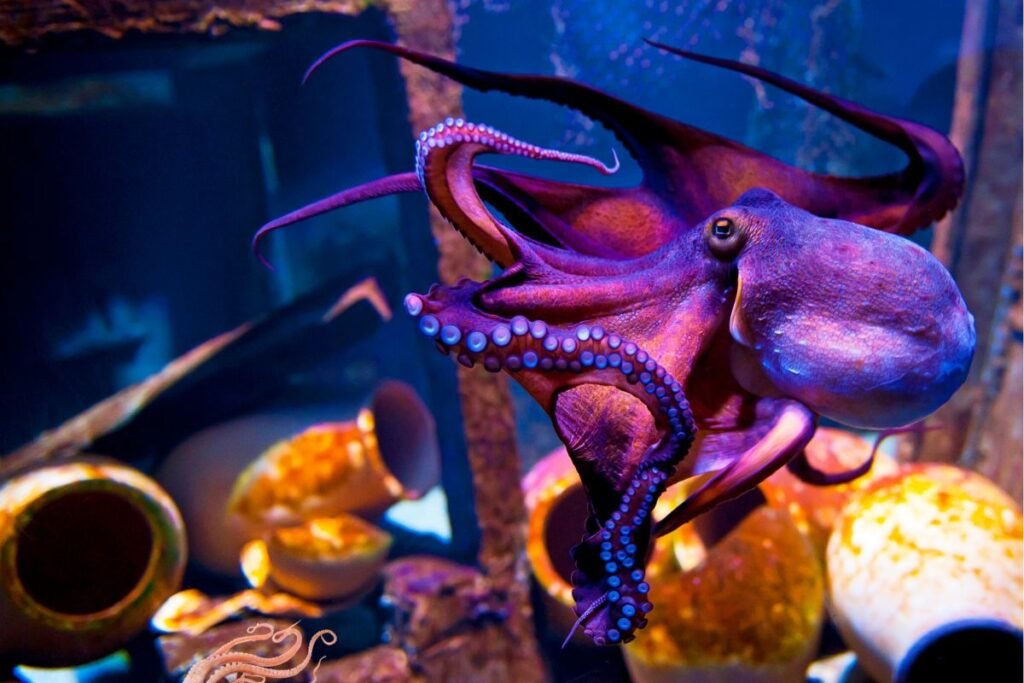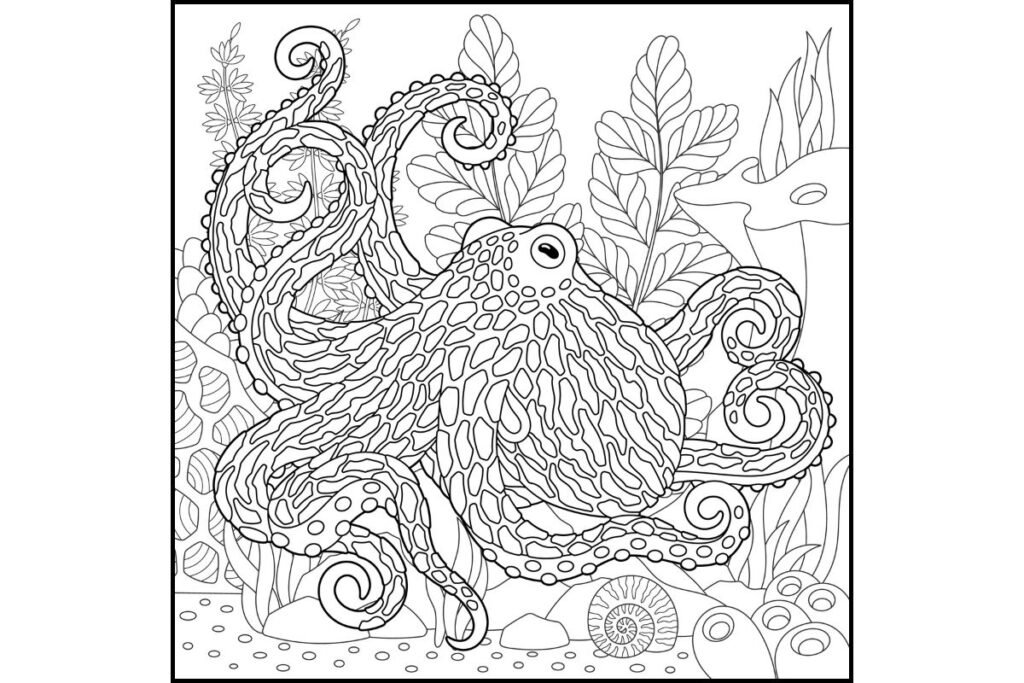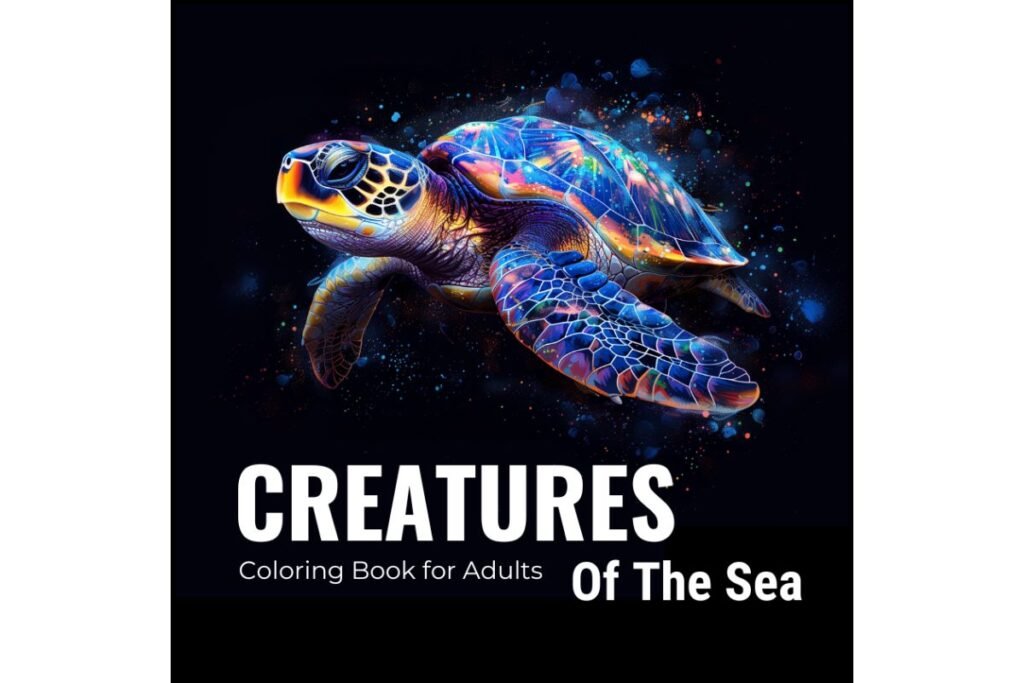Table of Contents
ToggleThe octopus, a marine marvel, captures the imagination of scientists and enthusiasts alike with its unparalleled intelligence, unique anatomy, and extraordinary behaviors.
This cephalopod mollusk, belonging to the class Cephalopoda, is distinguished by its eight limbs, a bulbous head, and a profound ability to adapt to its environment.
Anatomy of the Octopus: A Masterpiece of Nature
The anatomy of the octopus is a testament to the wonders of evolution. Its most recognizable features are the eight arms, each lined with suction cups that can taste and grasp objects.
Unlike vertebrates, the octopus lacks a rigid skeleton, which allows it to squeeze through incredibly narrow spaces. This flexibility is facilitated by a complex muscular system that provides both strength and dexterity.
The octopus’s head houses its advanced brain, eyes, and other vital organs. The brain is large relative to its body size, a trait that correlates with its high intelligence. The eyes of the octopus are particularly noteworthy; they possess a horizontal slit-shaped pupil, providing exceptional vision even in low-light conditions.

Behavior and Intelligence: The Brainpower of the Ocean
Octopuses are renowned for their cognitive abilities. They exhibit behaviors such as problem-solving, mimicry, and the use of tools, which are rare in the animal kingdom. Researchers have documented octopuses opening jars to retrieve food, escaping enclosures, and even using coconut shells as portable shelters.
One of the most fascinating aspects of octopus behavior is their capacity for camouflage. Through specialized cells called chromatophores, octopuses can change the color, texture, and pattern of their skin to blend seamlessly with their surroundings, evading predators and ambushing prey.
Habitat and Distribution: The Octopus’s Domain
Octopuses inhabit various marine environments across the globe, from coral reefs to the dark depths of the ocean floor. They are predominantly found in temperate and tropical waters, thriving in both coastal regions and the open sea. Their adaptive nature allows them to occupy diverse ecological niches, from shallow tide pools to abyssal zones.
The common octopus (Octopus vulgaris) is one of the most widespread species, found in the Atlantic, Indian, and Pacific Oceans. It prefers rocky crevices and coral reefs, where it can hide from predators and hunt for crustaceans, mollusks, and small fish.
Reproduction and Life Cycle: The Circle of Life
The reproductive strategies of octopuses are as intriguing as their behavior. Mating involves the male octopus using a specialized arm called a hectocotylus to transfer spermatophores to the female. After fertilization, the female lays thousands of eggs, carefully tending to them until they hatch.
The incubation period varies by species, but during this time, the female often forgoes eating, dedicating herself entirely to protecting her eggs. Tragically, most female octopuses die shortly after their eggs hatch, having expended all their energy on the next generation.
The lifespan of an octopus is relatively short, typically ranging from six months to five years, depending on the species. Despite their brief lives, octopuses play a critical role in marine ecosystems as both predators and prey.

Predators and Defense Mechanisms: Survival of the Craftiest
Despite their intelligence and adaptability, octopuses face numerous predators, including sharks, eels, and larger fish. Their primary defense mechanism is their ability to camouflage, which allows them to evade detection. When threatened, an octopus can release a cloud of ink to obscure the predator’s view and make a swift escape.
Another fascinating defense mechanism is the autotomy of their limbs. An octopus can voluntarily shed an arm to distract a predator, giving it time to flee. Remarkably, the lost arm can regenerate over time, a process that underscores the regenerative capabilities of these incredible creatures.
Diet and Hunting Techniques: Masters of the Hunt
Octopuses are carnivorous, with a diet that primarily consists of crabs, shrimp, mollusks, and fish. They employ various hunting techniques, often demonstrating remarkable cunning and versatility. Some species are ambush predators, lying in wait and then pouncing on unsuspecting prey. Others are active hunters, using their keen eyesight and agility to chase down their meals.
One of the most effective hunting methods involves the use of venom. Octopuses possess a beak-like structure that can deliver a venomous bite, paralyzing their prey. This venom, combined with digestive enzymes, breaks down the prey’s tissue, allowing the octopus to consume it more easily.
Octopuses in Culture and Mythology: Legends of the Deep
The octopus has long captivated the human imagination, featuring prominently in myths, legends, and folklore across various cultures. In ancient Greece, the octopus was associated with the sea god Poseidon and symbolized intelligence and adaptability. In Japanese culture, the octopus appears in numerous art forms, often representing mystery and the unknown depths of the ocean.
Modern popular culture continues to celebrate the octopus, with appearances in literature, film, and art. The image of the octopus often evokes a sense of the exotic and enigmatic, symbolizing the mysteries that lie beneath the ocean’s surface.

Conservation and Threats: Protecting the Octopus
Despite their resilience, octopuses face significant threats from human activities. Overfishing, habitat destruction, and climate change pose severe risks to their populations. As ocean temperatures rise and acidification increases, the delicate balance of marine ecosystems is disrupted, affecting octopus habitats and food sources.
Efforts to conserve octopus populations are crucial for maintaining the health of marine ecosystems. Sustainable fishing practices, marine protected areas, and research into the impacts of climate change are essential strategies for preserving these remarkable creatures for future generations.
Conclusion: The Enigmatic Octopus
In conclusion, the octopus is a testament to the wonders of the natural world. Its unique anatomy, advanced intelligence, and fascinating behaviors make it one of the most intriguing creatures in the ocean. As we continue to study and learn from the octopus, it becomes increasingly clear that this marine marvel holds many secrets yet to be discovered.
Protecting and conserving octopus populations is not only vital for their survival but also for the overall health and diversity of our oceans.


